- Home
- Countries & Regions
- Latin America
- Ecuador
- Topics & Events
- Ambassador of Japan, Yuji Sudo visited the institutions involved in the project.
Topics & Events
January 10, 2020
Ambassador of Japan, Yuji Sudo visited the institutions involved in the project.
From January 9 to 10, 2020, the Ambassador of Japan visited Salinas, one of the pilot cities, the National Risk and Emergency Management Service (SNGRE), executing institution of the "Project for the Construction of Safe and Resilient Cities against Earthquakes and Tsunami Disasters "(PCSR), and the Navy Oceanographic Institute (INOCAR).
On January 9, the first day of his visit, he toured the city of Salinas, exchanged points of views with Mr. Mayor Daniel Cisneros Soria regarding the progress of the project, disaster prevention, and reviewed the tsunami inundation map created by INOCAR. A Salinas city tour was conducted along the coast, from the municipality to the hill El Morro, at the tip of the cape, which is a refuge during a tsunami. Likewise, he verified the evacuation routes in case of a tsunami and the altitude signboards installed within the framework of the project. The ambassador also visited the site where the emergency alert system (siren) donated by the Embassy was installed under the Non-Refundable Financial Assistance for Community Human Safety Projects.
The second day, he visited INOCAR and SNGRE to verify the progress of the project and the operation of tsunami monitoring and alert system in Ecuador. The Director of INOCAR, Patricio Hidalgo Vargas, expressed his gratitude for the technical assistance of Japan after the "Project for Improvement of Earthquake and Tsunami Monitoring Capacity for the Early Tsunami Warning in Ecuador", predecessor of PCSR. In Tsunami Monitoring room of INOCAR work three officials who graduated from the JICA training program "Seismology, Seismic Engineering and Tsunami Disaster Prevention" and from which they obtained a master's degree. Ít was explained that tsunami monitoring and alert system in Ecuador has greatly improved in recent years thanks to the support of Japan, and explained the tsunami inundation maps of pilot cities of the project, the procedure for transferring tsunami information and content of this information to be broadcasted.
At SNGRE, project executing institution, the Deputy secretary of Information Management and Risk Analysis, Andrea Hermenejildo, and other parties involved in the project provided an overview of SNGRE work and the progress of the project. In this project, three main outputs are sought (tsunami rapid evacuation, update of the risk reduction agenda, improvement of the operating system of the construction systems) for the six pilot cities and the exclusive economic zone (EEZ) of Galapagos Islands. It was explained that their activities have progressed smoothly and that the tsunami evacuation plan and the risk reduction agenda in three main pilot cities have greatly improved thanks to the support of the project and Japanese experts.
In meetings with each institution, Ambassador Sudo said that since Ecuador and Japan established diplomatic relations in 1918, exchanges in various fields, such as politics, culture, economy and assistance for the past 100 years, have deepened development, and considering that both countries are prone to disasters, therefore, it seeks to further deepen exchanges through disaster prevention field.
Thanks are expressed to Ambassador Sudo, embassy officials and other institutions that cooperated and coordinated in territory during the tight schedule.
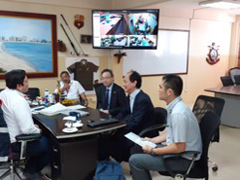 Meeting with the mayor of Salinas
Meeting with the mayor of Salinas
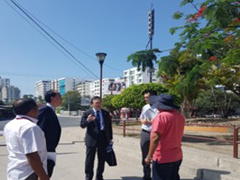 Tour to tunami evacuation route
Tour to tunami evacuation route
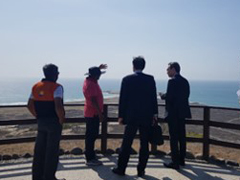 Visit to the hill El Morro at the tip of the cape
Visit to the hill El Morro at the tip of the cape
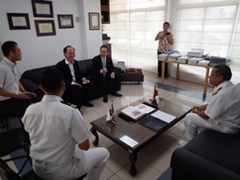 Meeting with INOCAR Director
Meeting with INOCAR Director
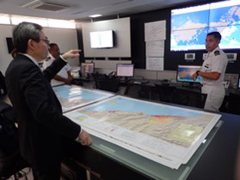 Explanation on monitoring and tsunami alarm system
Explanation on monitoring and tsunami alarm system
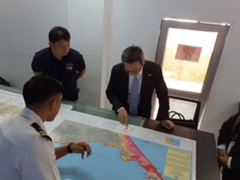 Explanation on inundation map
Explanation on inundation map
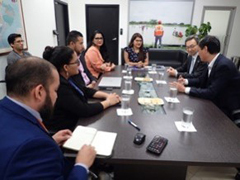 Meeting with SNGRE
Meeting with SNGRE
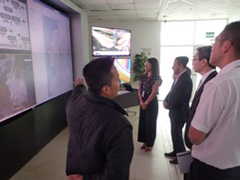 Visit to disaster monitoring center
Visit to disaster monitoring center
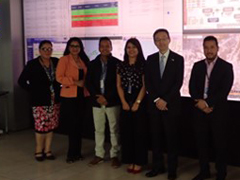 SNGRE officials and Ambassador Sudo
SNGRE officials and Ambassador Sudo
- About JICA
- News & Features
- Countries & Regions
- Our Work
- Thematic Issues
- Types of Assistance
- Partnerships with Other Development Partners
- Climate Change / Environmental and Social Considerations
- Evaluations
- Compliance and Anti-corruption
- Science and Technology Cooperation on Global Issues
- Research
- JICA Development Studies Program / JICA Chair
- Support for the Acceptance of Foreign HRs / Multicultural and Inclusive Community
- Publications
- Investor Relations
